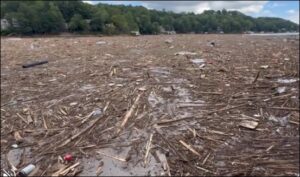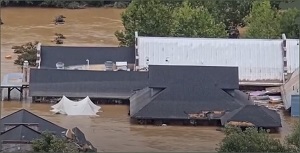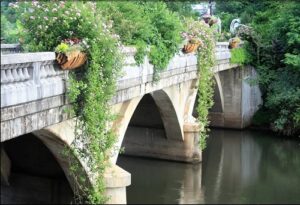~~ and ~~
~~ recommended by newestbeginning ~~
A real-life example from one North Carolina community (Scroll to the end to listen)Since Hurricane Helene tore through the southeastern United States, I’ve read numerous stories about what Project 2025 will do to federal disaster response. Today, I aim to do better than parroting what Project 2025 says. Using a real-world example, I hope to explain what it could mean for YOU or yours. Which could include MAGA voters in your lives.But first, a refresher for new subscribers. I wrote about Republican plans to gut federal disaster relief, weather science, and flood insurance way back in February, when nobody was thinking about hurricane season. I was among the first to report these aspects of Project 2025. I include links to those newsletters below.
For those lacking time to read three newsletters, Project 2025 will:
What does this actually mean in real life?In 2008, my husband and I bought a piece of land near Burnsville, North Carolina (but this area could be mirrored in parts of Georgia, Tennessee, Virginia, Kentucky, West Virginia, and Pennsylvania.) We spent a lot of time on that crag of rock at a bend in the North Toe River, enough to want to own a sliver. Circa the mid-aughts economic crisis, hiking crude trails and traversing one-lane bridges and getting lost in hollers was an escape from our stressful lives. Burnsville is in Yancey County. A link to demographics is HERE, showing it to be a poorer, predominately white area. County residents voted 66% for Donald Trump in 2020. It isn’t packed with gated communities and wealthy vacation homeowners. Until a decade or so ago, it was dry (meaning we had to stock up on alcohol in Asheville if we wanted an adult beverage in our rented cabin.) We never put a house on that land, but we’ve spent a lot of time in Western North Carolina. We couldn’t drive to our property today because:
Let’s talk about how state and municipal governments fund infrastructure projects like roads and bridges.I spoke to a person with experience obtaining federal funds for infrastructure projects at the municipal level. According to him, the only way MOST roads or bridges get built is with significant federal funds, in addition to state and county investments. In normal, non-disaster times, it is easier to convince state and county taxpayers to fund 25% of the cost of a major road replacement or expansion if their elected officials tell them 75% of the cost will be footed by the federal government, which is typical in many American communities. Infrastructure building is expensive. Almost half of it happens because of federal investment. An influx of federal funds is The ONLY way these repairs are realized after a disaster.Project 2025 calls for state and local governments to foot those bills without federal assistance. Thus, their citizens will pay for them with increased taxes. The impact can be significant. Let’s show what that means with an example. Imagine it’s a year from today, and Republicans won the November election. There is no NOAA and no FEMA for all but “major” disasters. The federal flood insurance program has been privatized, and millions of customers have been dropped without warning. States and counties have been told to buckle up and pray this hurricane season, because they’re on their own to fix any damage not deemed “major.” Another hurricane rips through the Appalachian mountains stronger than projected and causes the carnage I bullet-pointed above. Yancey County, NC (where Burnsville is located) had 18,500 residents at last count. Some people (like us) own property but don’t live there, so let’s round that number up to an even 25,000 properties to get our tax base. If the storm does the kind of damage Helene has, there will be a need to clear landslide debris, shore up mountainsides, rebuild roadbed, and replace bridges along a short section of State Road 197 that parallels the North Toe River from Green Mountain to Toecane, North Carolina (approximately 8 miles of road at $5 million per surface mile = $40 million.) Replacing two bridges would cost an additional $4 million. A minor road that serves an essential link for a small population could be a $44 million necessity. Before the election, FEMA would have supplied funding and resources for much of this work, but if the Project 2025 federal government doesn’t deem this damage “major” and chooses not to fund cleanup and repair, the state of North Carolina and Yancey County must organize and pay for it themselves. On average, the state/local split for road infrastructure projects is 60/40, so in this case Yancey County taxpayers will be on the hook for $17.6 million. With a tax base of 25,000 properties: $17.6 million / 25,000 properties = $705 average tax levy per property just to repair ONE road after ONE disaster in ONE community in ONE county.Many counties, especially in the southeast, provide tax breaks for higher dollar properties, meaning lower dollar properties pay higher taxes per square foot/acre than higher dollar properties, which would be exacerbated by a weather event like Helene. It could create hundreds of such needs across the county and state, which could cascade the tax levy by a factor of ten or more on each individual property owner. Can you imagine swallowing such a tax increase? Or being faced with another such increase after every subsequent disaster? Scores of communities that vote for Republicans would face tax increases and reduced disaster services if Republicans win in November, all mandated by Project 2025. Some might argue they deserve this projected fate for voting against themselves and their interests. I say we share this information with them — right now, while it’s top of mind — to make a difference in November.xxxxxxxxxxxxxxxxxxxxxxxxxxxxxxxx Half of All Deaths from Hurricane Helene Occurred 485 Miles North of Where It Made LandfallBy Pam Martens and Russ Martens: September 30, 2024 ~ As an unprecedented humanitarian crisis was happening in real time yesterday morning in Western North Carolina, we turned on the Sunday News programs: CNN’s State of the Union with Jake Tapper and, later in the morning, Face the Nation on CBS. We were stunned that the focus of both programs was the war in the Middle East and the presidential election. As both national news programs were airing, local news reports were coming out of Buncombe County, North Carolina that people there had no electric power, no running water, no cell phone service, impassible roads, and no distribution centers had been established for bottled water or food because the tractor trailers with the supplies had not arrived — two days after the hurricane hit. At the 10 a.m. press briefing by Buncombe County officials, 10 people were reported dead from Hurricane Helene with 1,000 reported missing. By the 4 p.m. press briefing, the number of deaths from the hurricane in just that one county had tripled to 30 according to Buncombe County Sheriff Quentin Miller, who spoke at both briefings. At that point in time, the deaths in Buncombe County represented more than a third of all deaths being reported by the five states most impacted by Hurricane Helene. Buncombe County, North Carolina sits 485 miles north of Perry, Florida, the town closest to where Hurricane Helene made landfall as a Category 4 hurricane at 11:10 p.m. on Thursday, September 26. Unprecedented levels of rainfall and surging rivers resulting from the Gulf of Mexico hurricane, led to deaths by drowning and fallen trees from saturated tree roots and heavy winds almost 500 miles away. Face the Nation on Sunday did include a brief interview with Deanne Criswell, Administrator of the U.S. Federal Emergency Management Agency (FEMA) – who appeared to be living in an alternative universe when she made this statement on the program about “several” homes being destroyed by Hurricane Helene: “We’re hearing significant infrastructure damage to water systems, communication, roads, critical transportation routes, as well as several homes that have been just destroyed by this. So, this is going to be a really complicated recovery in each of these five states that have had these impacts.” Hundreds of homes have been reduced to toothpicks by record storm surge. States with major damage from Hurricane Helene include Florida, Georgia, South Carolina, North Carolina and Tennessee. Early this morning, CBS News reported a total of 116 deaths in all states from Hurricane Helene. Of the 46 deaths reported as of 3:25 a.m. EDT today in the state of North Carolina, Buncombe County deaths represent 65 percent. One North Carolina county where an official death toll has not yet been announced is Rutherford County, home to the town of Chimney Rock and its sister community, Lake Lure. According to a video posted by a local resident, unprecedented raging waters from the Broad River have completely decimated Chimney Rock, with many homes reduced to toothpicks flowing downstream. The big question for that area is were the people asleep in their now decimated homes when the raging Broad River broke its banks or had they evacuated. According to surviving area residents, they received no evacuation orders or texts. An unconfirmed report indicates that the area’s pride and joy, the Lake Lure Flowering Bridge, has been destroyed by raging flood waters. Its website describes it as follows: “The Lake Lure Flowering Bridge is home to more than 2000 species of plants, lovingly tended by local volunteers. From the Bridge, visitors can look upstream to view the famous Chimney Rock, and downstream where the river flows into Lake Lure surrounded by the foothills of the Blue Ridge Mountains. There is always something to see as the plant and garden decorative displays change with the seasons. Visitors often comment on the unexpected blooms that appear at unusual times due to the isothermal microclimate of Hickory Nut Gorge. Even in the coldest months, festive lighting invites a walk across the Bridge both day and night. Our unique gardens are free and open to the public all year. The vast majority of the gardens are wheelchair accessible.” At the 4 p.m. Buncombe County press briefing yesterday, County Manager Avril Pinder said that search and rescue crews continue to work and that she was aware that there are areas in Fairview, Black Mountain, and Swannanoa “where the devastation is unthinkable” and “loved ones are still trapped.” Anthony Penland, the Fire Chief of the Swannanoa Fire Department, stated at the 4 p.m. press briefing that entire neighborhoods are gone and search and rescue teams are going to where the neighborhoods once stood and continuing search and rescue operations. A representative from Duke Energy, the primary electric utility in the area, also spoke at the briefing, saying that some substations are completely underwater and will need complete rebuilding. It is abundantly clear that Western North Carolina needs immediate assistance from a vastly expanded FEMA effort, a taskforce from the Army Corps of Engineers, a dramatic increase in the National Guard, immediate airlifted water and food supplies, and the immediate establishment of distribution centers for those supplies. |








No comments:
Post a Comment